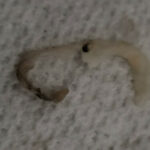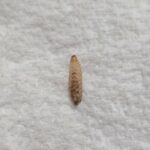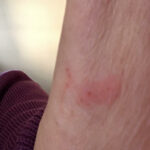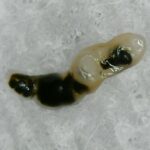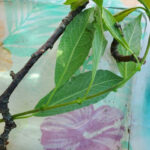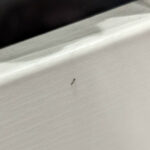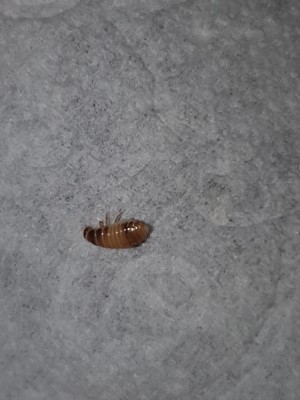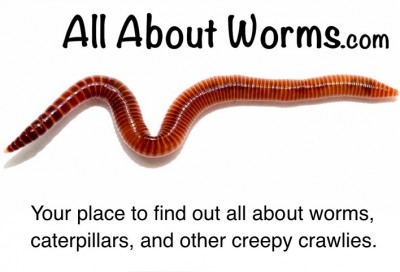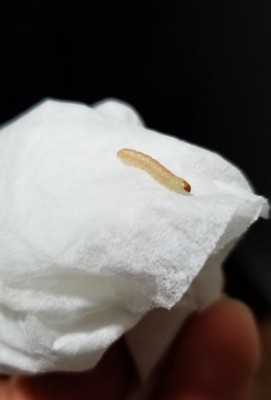Pitch moth larvae of the Sequoia pitch moth dominate the life span of this insect. According to the University of California Agricultural and Natural Resources (UC IPM), the pitch moth spends most of its life in the larval stage. Adult pitch moths, Synanthedon sequoiae, are active between May through early September. This means, not all pitch moths emerge from pupae at the same time. This insect occurs from California north through British Columbia, but it emerges earlier at warmer inland sites, and later at cooler sites near the coast. The insect peaks between June and July and the adult lives just a few days. During this time, the adults mate and females lay eggs.
The eggs can be found in bark and they are usually individual, not in clusters. These individual eggs are buried in crevices around pruning wounds and other injury sites. The eggs blend in well as they are reddish brown in color and oval shaped. They are around 1/16 inch in diameter and flattened. The pitch moth eggs hatch in 14 days, at which time they begin feeding for several months. The larvae, which may be dingy white, gray, or pink excavate “a shallow cavity that penetrates the inner bark to the cambium surface of wood.” Once feeding has ceased, the larvae will spend 30 days in the pupal stage. Pupae are dark brown and 3/4 inch long. The pupae can be found in silk-lined chambers within the pitch mass.
According to UC IPM, before adults emerge, “the pupae force about half of their length through the pitch surface, leaving a brown, paperlike case after they emerge.” A select number of individuals will complete the developmental stage within 12 months, but most take up to 24 months to develop from egg to adult.
The Sequoia pitch moth can do damage to trees, but most of it is cosmetic in nature. In pines, larval feeding promotes production of a resin that is considered unattractive, but harmless. The adult moth causes little to no damage to cambium and wood. The small amount of damage rarely causes girdling of the trunk and it rarely kills trees. Young trees are susceptible to limb damage. Larval feeding may cause young tree branches to die or become weak and break. The pitch moth prefers to attack pines with pruning wounds or other injuries. UC IPM states found that “damage is prevalent in certain pines planted in landscapes, such as Monterey pine.”
The following information is from the UC IPM website. For more information, please visit the official University of California Agricultural and Natural Resources website at www.ipm.ucdavis.edu.
Cultural Control
Small limbs infested with larvae and pitch masses can be pruned off, but this may lead to future infestations around the pruning wound. If pines must be pruned, prune only from October through January so that injuries begin to close before the egg-laying adults emerge in spring. Prune in a way that enhances wound closure, such as by making cuts just outside the branch bark ridge.
Stake pines only if needed to protect or support the trunk or to anchor the rootball during the first year or so after planting. If the tree was rigidly staked in the nursery, remove the stakes and (if needed) restake the plant. Do not fasten trunks firmly; allow the main stem to flex without rubbing on stakes because some movement with the wind is needed for trunks to develop strength. Remove ties and stakes promptly when they are no longer needed, usually within 2 years after planting.
Keep weed trimmers and lawn mowers away from trunks; for example, maintain a several-foot-wide area around trunks free of turf and other vegetation. Protect trunks from other sources of injury, such as from vehicle bumpers.
Plant only species that are properly adapted to the area. Certain pines are much less susceptible to sequoia pitch moth than others. Consider planting a more resistant species. Learn the cultural requirements of pines and provide proper care to maintain vigorous growth. Appropriate irrigation is especially important to tree health. Inappropriate watering is probably the most common problem with landscape plants. Trees are damaged by watering too frequently or by inadequate irrigation. When irrigating trees, apply water beneath the outer canopy, not near trunks. Avoid frequent, shallow watering that is often used for lawns. A general recommendation is to irrigate infrequently (possibly once a month during drought periods) but with sufficient amounts so that the water penetrates 1 to 2 feet into the soil. This can be achieved by applying water slowly through drip emitters that run continuously for about 1 to 3 days. The specific amount and frequency of water needed varies greatly depending on the site and tree species.
Physical Control
Scraping away or prying off resinous pitch cankers is the only direct method of controlling pitch masses and larvae, except possibly for pruning off smaller branches. If resin masses are carefully excised, larvae or pupae can be found and killed. Properly removing pitch masses from all nearby trees, along with appropriate cultural practices, can reduce reinfestations and control local clearwing moth populations. Inadequate application of pitch mass removal technique allows the larva or pupa to survive and mature into an adult that can reinfest trees. Only one larva or pupa occurs in each pitch mass, although several adjoining masses sometimes merge. Unless the mass has become reinfested, no insect will be present in masses older than about 2 years because the insect will have matured and emerged as an adult.
Each pitch mass gradually enlarges, hardens, and darkens as the larva beneath it matures. Learn to distinguish newer pitch masses from older ones in order to recognize where the insect is most likely to be found. Larvae are easily overlooked because their pinkish to gray color resembles the color of pitch. Young larvae (those found in smaller, pinkish masses) typically occur below the bark surface within a small cavity that they have chewed in the inner bark. Pupae and older, larger larvae occur in grayish pitch masses. These older insects are usually found near the surface of the mass, somewhat outward from the bark cavity they had created when younger. If pitch masses are simply scraped away without actually locating and killing or disposing of the larva or pupa, the insect can survive and cause a new pitch mass to develop at that site. Pupae or older larvae can survive in discarded pitch masses unless insects are crushed or bagged and disposed of away from trees.
All About Worms is always free, always reader-supported. Your tips via CashApp, Venmo, or Paypal are appreciated! Receipts will come from ISIPP Publishing.




